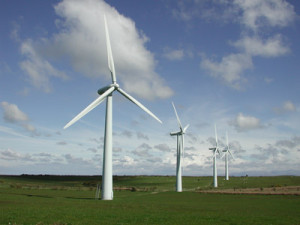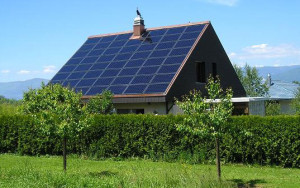I just love Earth 911– Here is an excellent- easy to read article about going off the grid!
Earth911 asked its Twitter followers, “If you had unlimited funds, what would be on your green wish list?” This series breaks down the most popular responses and how to make them a reality.
If you live on the grid, then electricity is supplied to you through a linked system typically from a coal, oil or natural gas plant. You plug in a device, flip a switch and bam! You’re making smoothies and watching TV in a matter of seconds. Why would anyone want to give up the grid?
For starters, how would you like to pay $0 in utility bills for the rest of your life? By going off grid you are completely disconnected from the power grid. Therefore, you pay nothing to utility companies.

Using a wind turbine along with solar panels assure that you will always have power. Photo: Ourworldfoundation.org.uk
Secondly, going off the grid has a positive impact on the environment. The U.S. electric power sector produces more than electricity. According to the Energy Information Administration, in 2007 electricity from coal, oil and natural gas contributed 5.3 trillion pounds of CO2 emissions into the environment. That’s a pretty hefty amount.
Going off the grid is more than just separating your home from the electrical grid. It’s a change in the way you live.
Day-to-Day Changes
When you go off the grid you cease reliance on outside sources of power, but that doesn’t mean you’ll be living in the dark ages. It just means that you supply your own electricity through a method such as the sun, wind or water.
You can continue to use your computer, hair dryer and all of your other comforts if you wish, but your usage of these items is dependent on how much energy is available. It’s not always as easy as flipping the switch for instant electricity. In an interview with Natural Life Magazine, Cam Mather, owner of an off-grid home in Ontario, describes the lifestyle change that comes with a renewable energy system:
“…we came to the realization that like everything on the planet, our electricity supply was finite. Some days there wasn’t enough electricity in the batteries to waste on powering the TV. So we made sure that what electricity we did use, we used efficiently…We have found that our activities more closely mirror nature and the weather. On sunny days we do laundry, both because it means we’ll have lots of power for the washing machine and to pump water…”
Living off grid takes planning of daily activities, but for most it is worth the adjustment, and if you start making changes prior to leaving the grid the transition will be much easier.
Prep Work
Before leaving the public utility system behind, do a little detective work and make some changes that will have a big impact on going off the grid.
1. Know Thyself: Get out your monthly electric bill to see how many kWh you’re using. Knowing how much electricity you’re using will help you identify the size of the system needed to power your residence. This in turn, gives you an idea of your upfront costs for this long-term investment.
2. Identify Energy Guzzlers: Spend $20 on a Kill A Watt, a device that plugs into your appliances and tells you how many kWh it uses. With this data you can determine how much you’re spending to keep it running or even if it’s working efficiently. This could be an excellent tool to help you adjust your energy consumption for optimal levels of conservation.
3. Switch to Energy Efficient Appliances: Start saving money and energy now by using your Kill A Watt to learn which appliances are draining your wallet. Then go to the ENERGY STAR Web site for a list of qualifying products and even rebates in your area. By having efficient appliances it will be less of a strain on your renewable energy system when it’s installed.
Knowing how much energy you’re using and cutting back on consumption will help determine how big a system you’ll need to be fully weaned off the grid.

Research your location’s weather history to find out what months are optimal operating times for solar panels. Photo: Georgiasouthern.edu
Let the Sun Shine In
At the heart of solar power are photovoltaic (PV) panels, an inverter and a battery. As Charles W. Bryant explains in his article “How Living Off the Grid Works,” essentially the panels’ silicon semiconductors separate out electrons from the sun’s energy.
An electric field directs the electrons one way forming direct current (DC). The inverter switches it from DC to alternating current (AC) for use in the home. A battery stores unused electricity.
Some things to consider for solar panel usage:
- Orientation and angle of inclination: Panels can be on the roof or the near the residence, but proper positioning determines whether or not you’ll be taking full advantage of the sun. It is best for panels to face true south and be unshaded; however, various orientations and inclines allow you to reap benefits at certain times of the day or year.
- Weather: Solar panels need the sun so it’s best to look up historical weather data to find out if you live in an area with some not so sunny months that will require a backup plan.
- System Size: Figure out your minimum system requirements based on calculations on previous energy usage.
- Cost: Even with a tax credit of 30 percent of the cost, PV systems can be pretty costly in the short term. It might be best to mix the use of solar with another natural power source such as the wind, which is a cheaper alternative.
The Answer is Blowing in the Wind
To utilize wind energy you need a wind turbine, an inverter and a battery. Julia Layton, writer of “How Wind Power Works” explains the workings of a wind turbine:
“When the turbine blades capture wind energy and start moving, they spin a shaft that leads from the hub of the rotor to a generator. The generator turns that rotational energy into electricity.”
The American Wind Energy Association recommends the following for residential wind turbine use:
- Location: Due to the size of the turbine, one-acre or more lots are recommended.
- Wind Speed: Average wind speeds should be at least 10 miles per hour.
- Tower Size: It varies by manufacturer, but you’ll want one that is tall enough so that turbulence from trees and other objects aren’t a factor in the performance of the turbine.
Typical images of wind turbines consist of propellers atop a tall pole, but Mariah Power created the Windspire, a 30’ tall 4’ wide propeller-free tower that is ultra quiet. Annually it produces about 2000 kWh of power, which could supply nearly 20 percent of the average household’s yearly energy.
In urban areas, the Windspire may not meet zoning codes, but Helix has developed a wind turbine that meets most local requirements. Specifically designed for residential use, the S322, standing as low as 15’, has a propeller-free design allowing it to capture wind that frequently changes direction.
Dual Harmony
If your environment allows, the best choice may be a combination of both solar and wind power. Powering a home solely with solar can be expensive even with the tax credit. Wind turbines, though not exactly cheap either, are less costly and are even more attractive with the tax credit. Plus, if you have both systems in place then you won’t be up a creek without a paddle on either a cloudy or windless day. You should be generating electricity no matter what the weather is like.
Going off the grid is an investment worth researching. By adjusting a few daily habits and creating your own power through natural, renewable resources, you not only cut back on dependence of fossil fuels but also reduce your carbon footprint. And as an added bonus, you’ll never have to pay an electric or gas bill again!

